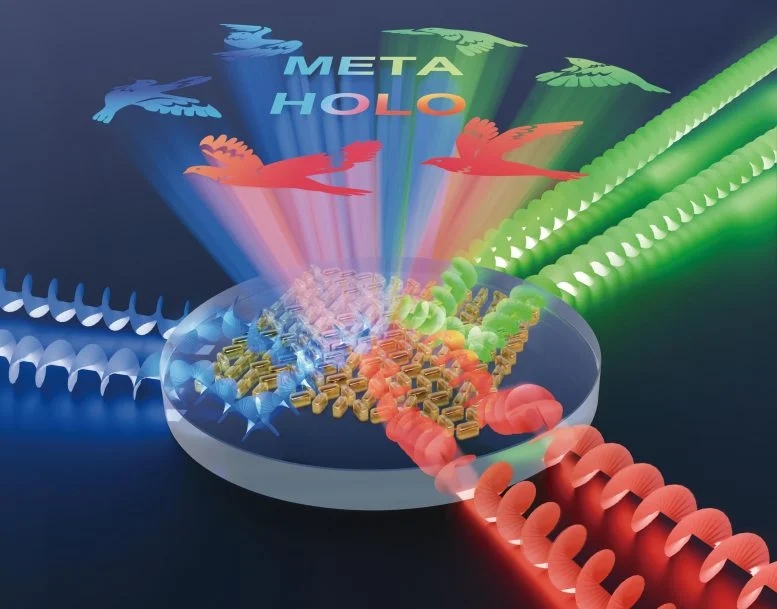博文
科学家已经开发出一种新的、更好的全息图
 精选
精选
||
科学家已经开发出一种新的、更好的全息图
诸平
据《科技日报》(SciTechDaily)网站2024年5月30日报道来自中国科学院长春光学、精密机械与物理研究所光出版中心(Light Publishing Center, Changchun Institute Of Optics, Fine Mechanics And Physics, Chinese Academy Of Sciences简称CAS)的消息,“元全息图”—— 科学家已经开发出一种新的、更好的全息图(“Metaholograms”–Scientists Have Developed a New, Better Type of Hologram)。
新的“元全息图”(“metaholograms”)可以通过实现无串音、高保真的图像投影,大大增加信息容量,从而改变增强现实(Augmented Reality简称AR)/虚拟现实(Virtual Reality简称VR)技术(AR/VR technologies)。研究人员已经开发出一种新型全息图,称为“元全息图”,能够投射多个高保真图像,没有串扰。这一创新为AR/VR显示、数据存储和图像加密等先进应用打开了大门。
与传统全息图相比,元全息图有几个优点,包括更宽的操作带宽、更高的成像分辨率、更宽的视角和更小的尺寸。然而,元全息图的一个主要挑战是其有限的信息容量,只能投射一些独立的图像。现有的方法通常只能提供少量的显示通道,并且在图像投影期间经常受到通道间串扰的影响。
创新研究方法(Innovative Research Approach)
为了克服这一限制,新研究引入了一种基于k空间平移设计策略(k-space translation design strategy)的创新方法,使多个目标图像能够在显示和隐藏状态之间无缝切换。所提出的元全息图采用几何相位编码方法(geometric phase encoding method),由数百万个亚波长尺度的多晶硅纳米柱组成,每个纳米柱的尺寸约为100 nm,它们的尺寸相同,但旋转角度在空间上不同。
该设备还集成了一个平面玻璃波导来传输入射光,并利用偏振和角度等特性来切换最多六个独特的高保真图像的投影,而不会产生串扰。
潜在的应用和未来的影响(Potential Applications and Future Implications)
此外,研究人员还利用不同的多路复用技术组合,创造了双通道全彩元全息图,甚至十八通道元全息图。这一创新有可能通过投影更复杂和逼真的场景来显著改善AR/VR显示。它还有望应用于图像加密,其中信息被编码到多个全息通道中以增强安全性。
该研究是开发高性能元全息图的重要一步,其信息容量大大增加。这项研究为从高级显示到信息加密和信息存储等各个领域令人兴奋的新可能性铺平了道路。
原文详见:Zeyang Liu, Hao Gao, Taigao Ma, Vishva Ray, Niu Liu, Xinliang Zhang, L. Jay Guo, Cheng Zhang. Broadband spin and angle co-multiplexed waveguide-based metasurface for six-channel crosstalk-free holographic projection. eLight, 2024, 4, Article number: 7. DOI: 10.1186/s43593-024-00063-9. Published: 29 May 2024. https://elight.springeropen.com/articles/10.1186/s43593-024-00063-9
参与此项研究的有来自中国武汉的华中科技大学(Huazhong University of Science and Technology, Wuhan, China)和美国密歇根大学(University of Michigan, Ann Arbor, MI, USA)的研究人员。
本研究得到了中国国家自然科学基金{National Natural Science Foundation of China (NSFC) under Grant Nos. 62075078, 62135004 and 62205113}、和武汉-曙光项目知识创新计划(Knowledge Innovation Program of Wuhan-Shuguang Project under Grant No. 2022010801020095)以及中国博士后科学基金(China Post-doctoral Science Foundation under Grant No. 2022M721244)的支持。
上述介绍,仅供参考。欲了解更多信息,敬请注意浏览原文或者相关报道。
Metasurface-based holograms, or metaholograms, offer unique advantages including enhanced imaging quality, expanded field of view, compact system size, and broad operational bandwidth. Multi-channel metaholograms, capable of switching between multiple projected images based on the properties of illuminating light such as state of polarization and angle of incidence, have emerged as a promising solution for realizing switchable and dynamic holographic displays. Yet, existing designs typically grapple with challenges such as limited multiplexing channels and unwanted crosstalk, which severely constrain their practical use. Here, we present a new type of waveguide-based multi-channel metaholograms, which support six independent and fully crosstalk-free holographic display channels, simultaneously multiplexed by the spin and angle of guided incident light within the glass waveguide. We employ a k-space translation strategy that allows each of the six distinct target images to be selectively translated from evanescent-wave region to the center of propagation-wave region and projected into free space without crosstalk, when the metahologram is under illumination of a guided light with specific spin and azimuthal angle. In addition, by tailoring the encoded target images, we implement a three-channel polarization-independent metahologram and a two-channel full-color (RGB) metahologram. Moreover, the number of multiplexing channels can be further increased by expanding the k-space’s central-period region or combing the k-space translation strategy with other multiplexing techniques such as orbital angular momentum multiplexing. Our work provides a novel approach towards realization of high-performance and compact holographic optical elements with substantial information capacity, opening avenues for applications in AR/VR displays, image encryption, and information storage.
https://blog.sciencenet.cn/blog-212210-1436423.html
上一篇:ANU脱盐技术突破,在全球变暖之际加强全球水安全
下一篇:新的研究证实,这种神奇的药物可以降低老年人的死亡风险


